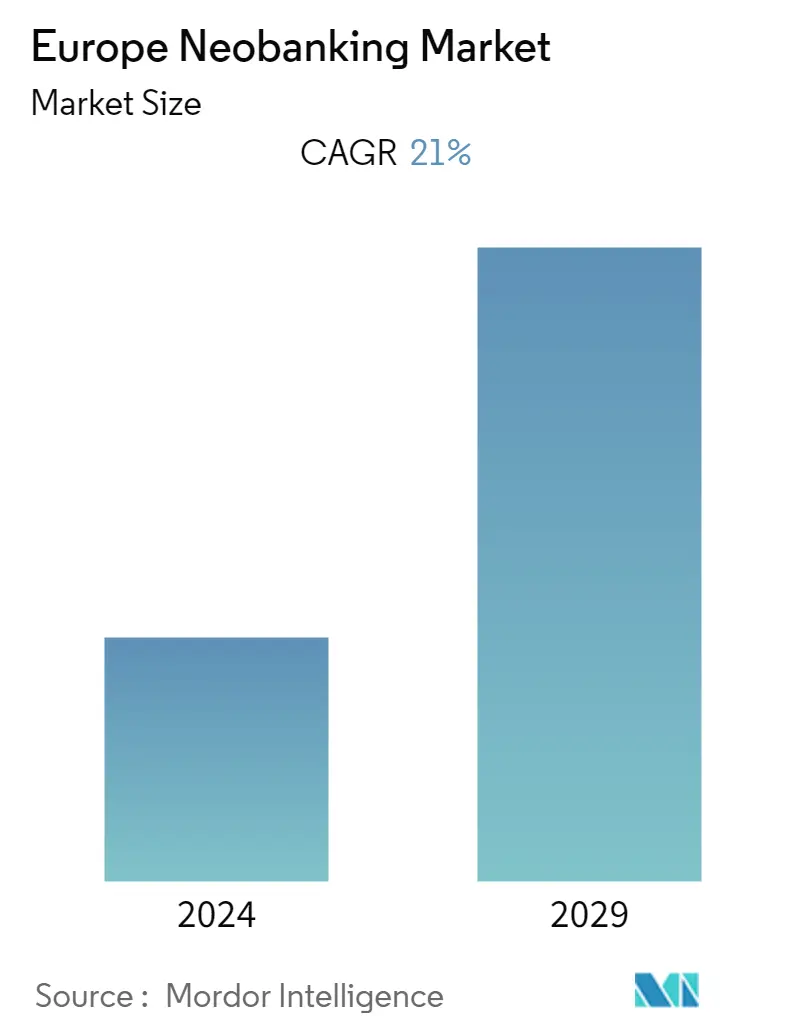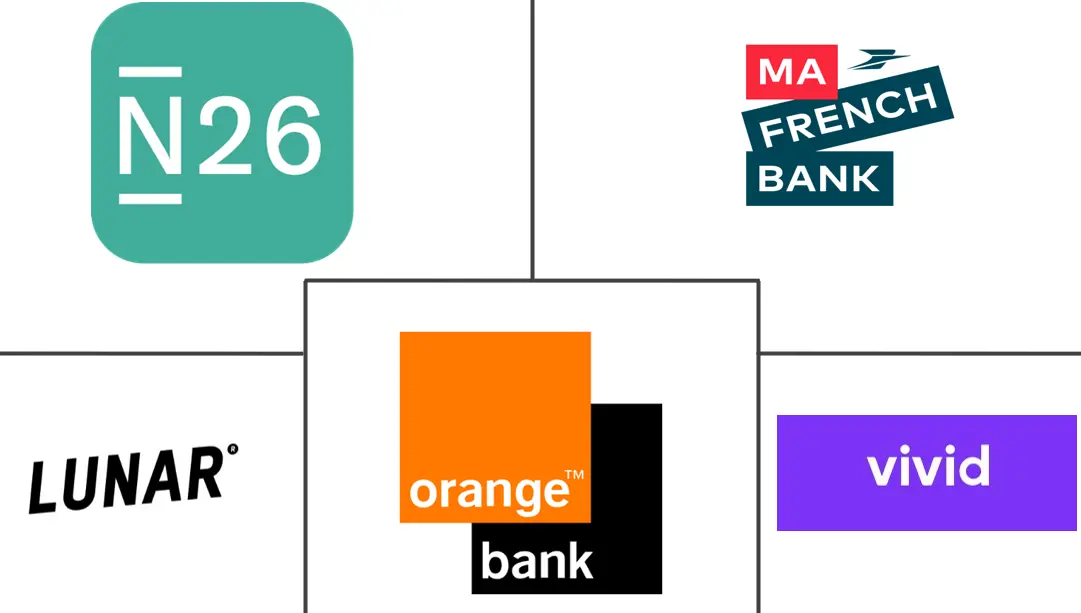Market Size of Europe Neobanking Industry

| Study Period | 2020 - 2029 |
| Base Year For Estimation | 2023 |
| Forecast Data Period | 2024 - 2029 |
| Historical Data Period | 2020 - 2022 |
| CAGR | 21.00 % |
| Market Concentration | Medium |
Major Players
*Disclaimer: Major Players sorted in no particular order |
Need a report that reflects how COVID-19 has impacted this market and its growth?
Europe Neobanking Market Analysis
Europe's Neobanking Market is estimated to have generated 2100 billion worth of transaction value in the current year and is poised to achieve a CAGR of 21% for the forecast period.
Neobanking is a novel banking technology that provides complete online banking solutions from opening an account to other services, without the need to go to a bank for its customers. Neobanking differs from traditional banks, as they have no physical offices & branches.
Europe holds the biggest market share in the Neobanking Market and accounts for over 30% share of the global revenue due to the establishment of multiple technology start-ups & the growing adoption of technology. The growing adoption of internet services and the increased use of smartphones are expected to accelerate market growth.
During the period of Covid-19 in 2020, Germany was having the highest user number in Digital Commerce with an average transaction value Digital commerce per user stood at a level of 2,084 US$ which stands at the second highest level after the United States. Higher and Middle-income level people contribute the most to an increase in the adoption of the Neobanking Market with restrictions made during covid for offline transactions.
Some banks are more vulnerable than others to the fallout from the COVID-19 crisis due to a weaker solvency position or individual business model characteristics. More than 2,000 small and medium-sized banks are directly supervised by national authorities. The ECB has taken measures to drastically mitigate banks funding risk, by providing new long-term central bank funding and making it easier to access this funding.
Europe Neobanking Industry Segmentation
The Europe Neobanking market is segmented by account type (Business account, Savings account), by services (Mobile-banking, Payments and money transfers, savings, Loans, Others), and By Country (Germany, Spain, Italy, Russia, France, United Kingdom, and Rest of Europe), various trends, opportunities, and company profiles. The report offers Market size and forecasts for the Europe Neobanking Market in value (USD Billion) for all the above segments.
| By Account Type | |
| Business Account | |
| Savings Account |
| By Services | |
| Mobile Banking | |
| Payments and Money Transfers | |
| Savings Account | |
| Loans | |
| Other Sevices |
| By Country | |
| Germany | |
| France | |
| United Kingdom | |
| Russia | |
| Italy | |
| Spain | |
| Rest of Europe |
Europe Neobanking Market Size Summary
Europe's Neobanking Market, a sector that offers comprehensive online banking services without the need for physical branches, has seen significant growth. This growth is largely attributed to the rise of technology start-ups and the increased adoption of internet services and smartphones. The region holds the largest market share in the global neobanking market, with the Covid-19 pandemic further accelerating the shift towards digital commerce, particularly among higher and middle-income individuals. Trends within the European Neobanking Market include an increasing user penetration of Neobanking apps, particularly among younger demographics, and a growing demand for neobanking services due to increased internet penetration. The neobanking model's cost-efficiency, simplicity, and enhanced services have made it a popular choice among consumers. The market is dominated by several key players, including N26, Vivid, Ma French Bank, Orange Bank, Lunar, etc, and continues to grow with the advent of technological advancements and service innovation.
Explore MoreEurope Neobanking Market Size - Table of Contents
-
1. MARKET INSIGHTS AND DYNAMICS
-
1.1 Market Overview
-
1.2 Market Drivers
-
1.3 Market Restraints
-
1.4 Insights on Technological innovation in the Neobanking Industry
-
1.5 Porters 5 Force Analysis
-
1.5.1 Threat of New Entrants
-
1.5.2 Bargaining Power of Buyers/Consumers
-
1.5.3 Bargaining Power of Suppliers
-
1.5.4 Threat of Substitute Products
-
1.5.5 Intensity of Competitive Rivalry
-
-
1.6 Insights on Government Regulations Landscape in the Neobanking Industry
-
1.7 Impact of COVID-19 on the Market
-
-
2. MARKET SEGMENTATION
-
2.1 By Account Type
-
2.1.1 Business Account
-
2.1.2 Savings Account
-
-
2.2 By Services
-
2.2.1 Mobile Banking
-
2.2.2 Payments and Money Transfers
-
2.2.3 Savings Account
-
2.2.4 Loans
-
2.2.5 Other Sevices
-
-
2.3 By Country
-
2.3.1 Germany
-
2.3.2 France
-
2.3.3 United Kingdom
-
2.3.4 Russia
-
2.3.5 Italy
-
2.3.6 Spain
-
2.3.7 Rest of Europe
-
-
Europe Neobanking Market Size FAQs
What is the current Europe Neobanking Market size?
The Europe Neobanking Market is projected to register a CAGR of 21% during the forecast period (2024-2029)
Who are the key players in Europe Neobanking Market?
https://n26.com/en, https://vivid.money/en-eu, https://www.mafrenchbank.fr, https://www.orangebank.fr and https://www.lunar.app are the major companies operating in the Europe Neobanking Market.
